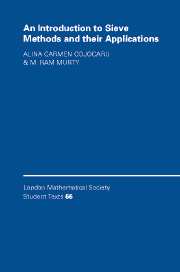Book contents
6 - Brun's sieve
Published online by Cambridge University Press: 23 November 2009
Summary
Viggo Brun (1885–1978) introduced the sieve that now bears his name in 1915 in the paper. It seems that Jean Merlin had made the first serious attempt to go beyond Eratosthenes. Unfortunately, he was killed in World War I (see) and only two of his manuscripts have survived, namely. The latter was prepared for publication by Jacques Hadamard (1865–1963) and published posthumously. Clearly, Brun read Merlin's papers very carefully and was inspired by them. Perhaps he was the only one to have done so. No doubt, this led to his 1915 paper on the subject and later these results were developed into a sophisticated sieve.
In his fundamental work, Brun proved that there are infinitely many integers n such that n and n + 2 have at most nine prime factors. He also showed that all sufficiently large even integers are the sum of two integers, each having at most nine prime factors. These represent tremendous advances towards the twin prime conjecture and the Goldbach conjecture. As a consequence of this work, he deduced that the sum of the reciprocals of the sequence of twin primes converges (see Corollary 5.4.5).
Brun's original papers on the subject were largely ignored. One story reports that Edmund Landau (1877–1938) had not looked at them for eight years, even though they were on his desk. Part of the difficulty lay in the unwieldy notation that Brun had used. Now, 80 years later, the ideas look simple enough and the notation has been streamlined.
- Type
- Chapter
- Information
- An Introduction to Sieve Methods and Their Applications , pp. 80 - 112Publisher: Cambridge University PressPrint publication year: 2005

